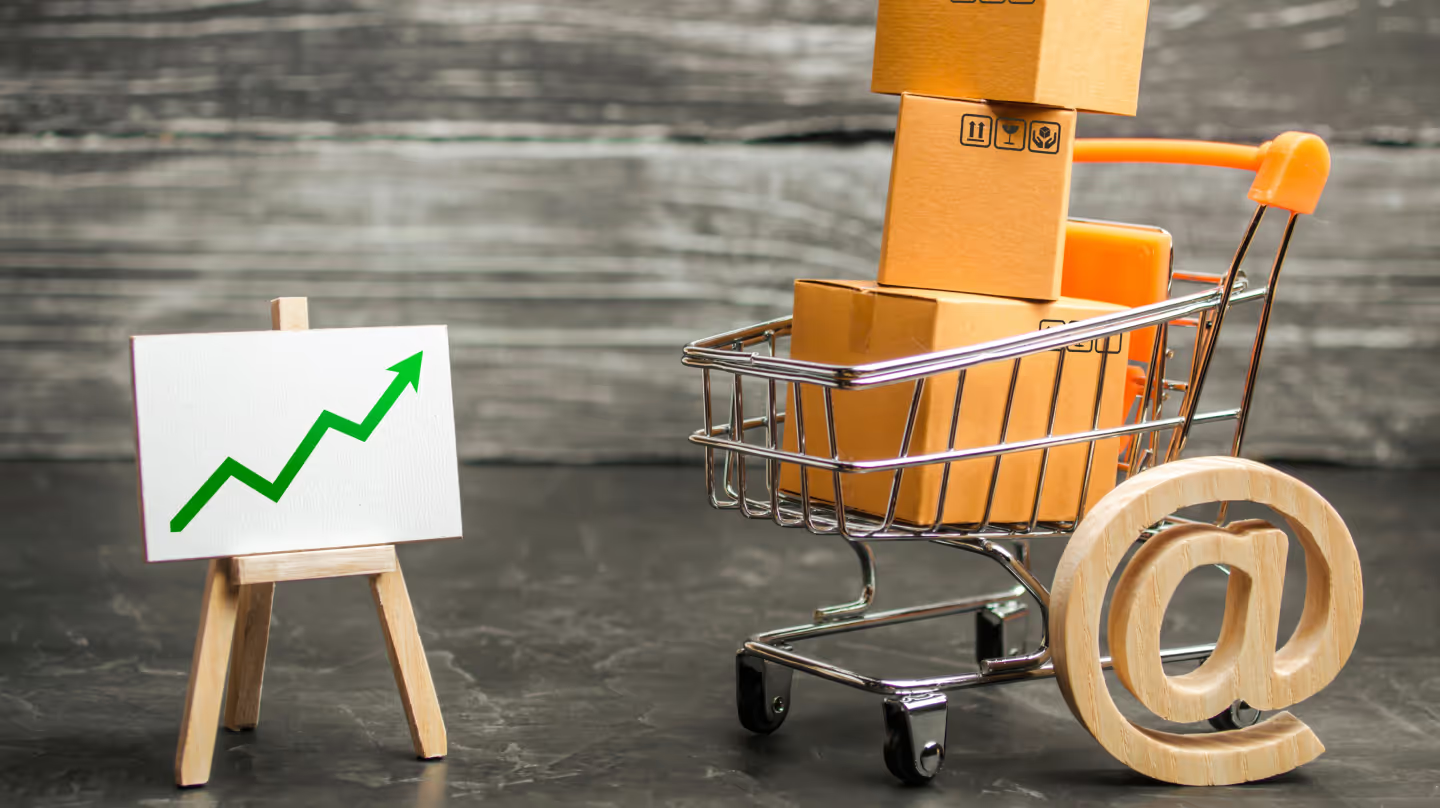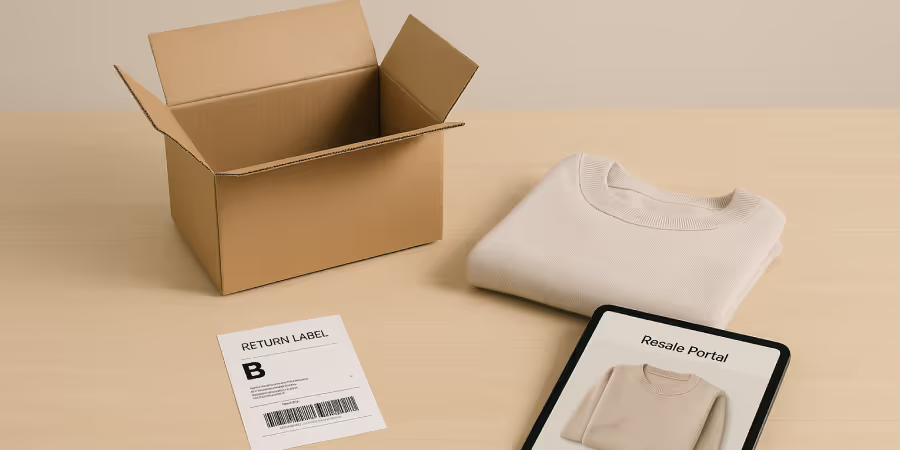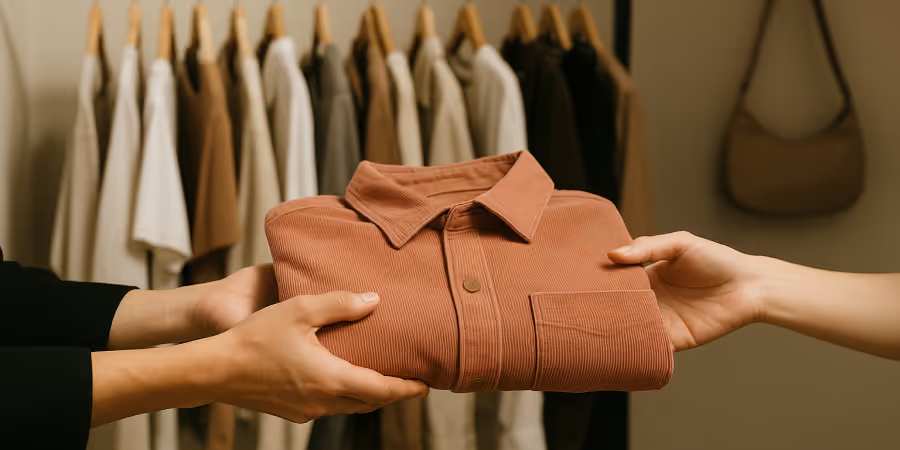Summary

The Issue Behind Traditional Commerce
Traditional commerce is built around one transaction: make, sell and move on. But when products are returned, overproduced, or sit unsold in warehouses, brands lose control, and billions in value.
In the DACH region alone, €3 billion in value is lost each year because up to 30 % of returned items and B-stock are never resold.
These are perfectly functional products, often new or nearly new, that simply never find a second life.

Meanwhile, Others Are Cashing In on Recommerce
While brands discard or store these products, others are turning them into profit.
The European recommerce market — powered by platforms like Back Market, Vinted, or Refurbed — is expected to almost double to €69 billion by 2030.
Yet most brands see little to none of that value, because resale happens elsewhere.
So, what are brands actually missing?
- Financially: lost revenue and higher storage or disposal costs.
- Strategically: no control over brand perception in the second-hand market.
- Sustainability-wise: wasted resources that contradict ESG goals.
All this sets the stage for branded resale, where companies reclaim ownership of their products’ second life, turning what used to be waste into profit, loyalty, and credibility.
What Is Branded Resale?
Branded resale means that companies take control of their own secondhand market, instead of leaving it to third-party platforms.
It’s when a brand runs the resale of its pre-owned, returned, or refurbished products under its own name, on its own channels, and with its own quality standards.
Rather than letting used products end up on Vinted, Back Market, or eBay, brands create an official way for customers to sell back their items, and for new buyers to purchase trusted refurbished or repaired ones.
These resale streams usually come from three main product sources:
- B-Stock: overproduction, display models, or slightly defective products that can still be sold as “like new.”
- Returns: items in perfect or nearly new condition that would otherwise sit idle in warehouses.
- Buy-back or Trade-in: used products that customers return at the end of their life cycle for store credit or cash.
When managed well, branded resale connects all these streams in one ecosystem, where every product can have a second (or third) life, and the value stays within the brand.

What are the benefits from Branded Resale?
When brands take ownership of their resale channel, they unlock multiple strategic advantages. Below are some of the most powerful benefits, each with data that back them up.
1. Acquire New Customers
Resale isn’t just a way to monetize used inventory, it’s a discovery engine.
According to ThredUp’s 2024 Resale Report, 65 % of incremental secondhand spend comes from shoppers who are new to the brand.
Similarly, BCG reports that 66 % of resale shoppers say that resale allowed them to discover or buy a brand for the first time.
That means in addition to serving existing customers, brand-driven resale channels open doors to audiences that might never have engaged otherwise.
2. Increase Loyalty & Retention
Buy-back and trade-in programs generate recurring touchpoints, and thus deeper relationships.
Every time a customer comes back to sell or upgrade, they re-enter your ecosystem rather than leaving it to random marketplaces.
Also, by validating and certifying the secondhand product, you maintain quality control and customer trust — which bolsters brand loyalty.
3. Lower Costs & Improve Supply Chain Efficiency
One often-overlooked benefit: by controlling the resale flow, brands can reclaim spare parts, refurbish components, or harvest materials for repairs or new production.
That reduces dependency on fresh raw materials or external suppliers, effectively lowering sourcing and manufacturing costs over time.
Also, dealing with returned or B-stock inventory becomes an internal “asset management” function instead of a loss or waste problem.
4. Drive Incremental Spending & Upsell
When resale and buy-back are connected, the impact on spending grows even stronger.
If customers receive a voucher when trading in their product and use it toward a new purchase, redemption typically leads to a 2–6× higher spending compared to an average transaction.
Integrating buy-back into the resale journey not only recirculates products but also accelerates revenue growth by bringing customers back sooner — and with greater intent to buy.
5. Strengthen Brand Equity & Sustainability Credentials
Consumers are more likely to resonate with brands that take accountability for the full lifecycle of their products.
According to accenture, 76 % of global consumers prefer to shop with retailers that repurpose materials or services.
And 62 % say they would buy more from a brand that officially partners with a secondhand or circular initiative.
These numbers show that circular practices are no longer “nice extras”, they drive real perception and loyalty.

6. Capture a Growing Market Opportunity
There’s momentum behind the recirculation-driven economy. For example, resale has grown by 650 % since 2018 in some markets. Entering early means capturing a share of that growth rather than reacting to it later.
Who Is Already Doing Branded Resale?
More and more brands are realizing that resale isn’t a side project, it’s a way to extend their business model, reach new audiences, and stay relevant in a changing market.
Here are three companies proving that branded resale works across very different industries.
IKEA: Giving Furniture a Second Life
IKEA has made circularity tangible for millions of customers through its “As-Is” and “Buy Back & Resell” programs.
Customers can return used furniture to their local store, where it’s repaired, cleaned, and resold at a reduced price. The concept keeps products in use, reduces waste, and helps IKEA move closer to its goal of becoming a fully circular company by 2030.
It’s a perfect example of how branded resale can fit seamlessly into an existing retail experience, practical, accessible, and profitable.
Read more: IKEA’s As-Is Section Explained
Patagonia: Turning Repair Into a Movement
Patagonia’s Worn Wear program is one of the most well-known resale initiatives in the world.
The outdoor brand invites customers to trade in their used jackets, pants, and gear in exchange for store credit. Each product is refurbished and resold online under the Worn Wear label — extending the lifespan of thousands of garments each year.
Beyond the environmental impact, Patagonia has built a community around reuse — showing that branded resale can deepen customer trust and reinforce brand values.
Read more: Patagonia’s Worn Wear: What Fashion Brands Can Learn
Tchibo: Circularity at Scale
Together with koorvi, Tchibo launched its first digital trade-in and resale program for coffee machines, covering everything from buy-back to refurbishment and resale.
Through our software, Tchibo can now manage every step of the process digitally: customers start a trade-in online, logistics are automated, and refurbished devices are resold directly to new buyers.
The program shows that branded resale isn’t limited to fashion or furniture, it’s just as powerful for household and electrical appliances, where quality and trust matter most.
Read more: How Tchibo Makes Sustainability Profitable

Is Branded Resale Worth It?
The short answer: absolutely.
Branded resale is no longer just a sustainability initiative, it’s a business strategy that drives profit, loyalty, and long-term competitiveness.
By owning the second life of their products, brands can unlock new revenue streams, strengthen customer relationships, and reduce both waste and sourcing costs. It’s a model that keeps value circulating, economically and environmentally.
And thanks to digital solutions like koorvi, running a resale or trade-in program has never been easier. From product intake to refurbishment, pricing, and resale, everything can be managed within one simple system.
In the end, branded resale helps companies do what every forward-thinking brand wants: grow revenue, build loyalty, and protect the planet.
👉 Learn how to launch your own branded resale program with koorvi.
FAQs
What does branded resale mean for a company?
Branded resale means a company takes ownership of its own secondhand market instead of relying on third-party platforms. It allows brands to take back, refurbish, and resell their products under their own name — keeping control over quality, pricing, and customer experience.
How is branded resale different from selling on third-party platforms like Vinted or Back Market?
Unlike third-party marketplaces, branded resale keeps the process in-house.
- You keep customer relationships and data
- You define pricing and quality standards
- You ensure consistent brand presentation and trust
Which products are best suited for a branded resale program?
The most suitable products are durable, repairable, and high in brand value. Typical sources include:
- B-stock: overproduction or display models
- Returns: unused or nearly new items
- Trade-ins: products customers sell back for credit
Appliances, electronics, kids’ products, textiles, and furniture often perform best.
Is branded resale profitable for brands?
Yes. Resale can increase both revenue and loyalty:
- Up to 65 % of resale buyers are new customers
- Trade-in vouchers lead to 2–6× higher spending
- Refurbished parts help reduce sourcing costs
It’s a model that turns waste into growth.
How can a brand start its own resale or trade-in program?
Identify your product streams, define refurbishment standards, and set up a resale channel — ideally integrated into your e-commerce.
Platforms like koorvi handle everything from intake and pricing to logistics and resale, making branded resale easy to launch and scale.
How does branded resale support sustainability and regulation compliance?
Resale extends product lifecycles and helps brands meet ESPR and EPR requirements. It cuts CO₂ emissions, reduces waste, and proves measurable circular impact — aligning sustainability goals with business results.




